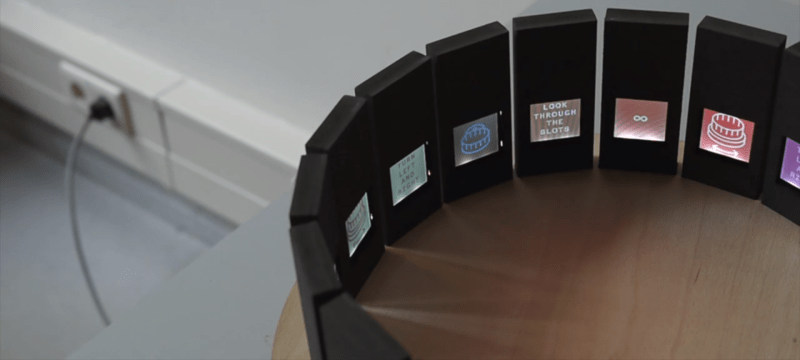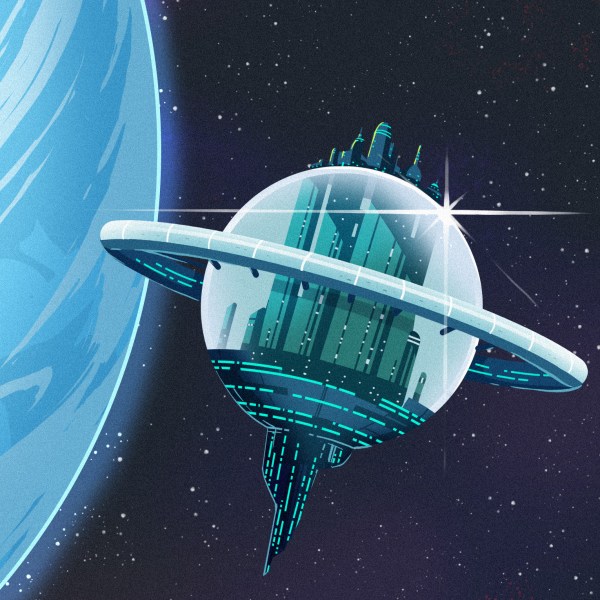[Jasper] sent in a project he, [Quinten], and [Mr. Stock] have been working on for a while. It’s called the Pristitrope and brings the classic 19th centrury paper-based animation device into the 21st century with 18 LCD displays.
The lazy suzan portion of the build was fabricated out of plywood cut on a CNC router and fastened together with the help of a slip ring to transfer power between the stationary and spinning portions of the device. For the electronic part of the build, eighteen LCD displays were connected together on a data bus with each display independently addressable by a microcontroller.
One really interesting feature of the Pristitrope is its ability to detect if it is currently rotating clockwise or counterclockwise. While [Quinten]’s video doesn’t show off the full possibilities of this feature, the spin sensor makes it possible to always have an animation played in the right direction regardless of how the Pristitrope is spun.

















1) this is awesome
2) i wish he had a BOM, i’d love to know what LCD module that is – i’m assuming it was cheap since he had to get 18, and a cheap RGB module is always good to have on hand!
We used the Sparkfun Nokia knock-off screen which you can control using spi. The board we use for each screen was designed by Mr. Stock and basically does nothing more than power the screen and sending the spi data to the next one using a buffer so the signal doesn’t get weaker.
oh, awesome! many thanks.
I’ve never said a disparaging word on this site in my life, but for once, I’m compelled to ask “WHY!?”
IMHO, it’s ‘kinda’ cool, but it really doesn’t seem to work very well…
maybe it’s just me. Sorry :(
Because it’s cool.
Because it’s cool and something you could easily expand upon. Set up a camera/Kinect/etc. that takes pictures in a timed sequence. Invite passers-by to do something. Take images, convert, send to LCDs, spin, and presto, instant interactive zoetrope.
I think an LCD and other display technologies are already kind of an instant, interactive zoetrope… “A zoetrope is a device that produces the illusion of motion from a rapid succession of static pictures.” Sounds like when I watch a movie on a TV ;)
If you don’t try something out that has never been done before you’ll never truly know the outcome.
The same could be said about homicide, but it usually doesn’t fly in court. I applaud the craftsmanship, But I do think the time was wasted. I made a paper version of this when I was a kid. Afterwards I felt my time was wasted. I wonder how they will feel when the internet moves on to “cooler” or more useful things.
Why? Because he can.
If he had fun doing it then who cares if it’s useful or not. The laser wouldn’t have been invented if the researchers hadn’t fooled arouned (they found laser to be a fun little side project with no real use).
Because discoveries don’t happen on their own. They happen when someone explores the “What if?”
This is awesome … Completely pointless … Yet that probably is the charm of this thing …
Nice work on the fabrication though.
You do know that 1 of these screens can handle all of the “animation” by itself, right? This is like a rube goldberg device. you should have made it start by swinging an old boot that kicks a bowling ball down a slide and in to a bucket on a string that flips the switch. cool? yes. useless? yes. Seems like a shame to be wasting all of those screens on this. maybe you could make it actually print to small rolls of thermal paper super fast. Now that would be cool.
who says they’re wasted… can take them out of the enclosures and repurpose them later if you wish… nobody cast them in resin or anything. sheesh.
This is a great. . . and absurd. Just my kind of art / project.
It’d be better with the screens facing out and a mask with a viewport to look through.
With such a setup it could do full speed animation using screens with a slow refresh rate.
A similar concept has been proposed to display shows and advertisements in long train tunnels, with the screens synchronized to the train speed so when passengers look out a window it appears as if the moving image is traveling with the train.
If you view through a pinhole instead of a slit and you arrange the displays in a grid – you can get a 3d display.
PDF warning (http://files.tachilab.org/publications/intconf2000/nii200708SIGGRAPHETECH.pdf)
Originally saw it at Siggraph 2007 Emerging Tech display using Nipkow disk for mechanical TV. You can use rotating mirrors instead of a Nipkow disk but geometry obviously different. YAY for NBTV.